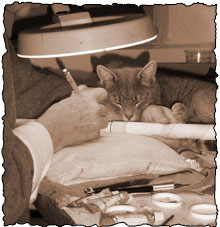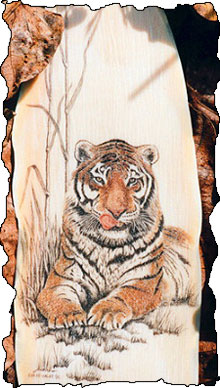 |
|
Originating among the whalers of the 18th century as a way to profitably fill the empty hours during
lengthy voyages, scrimshaw art originally consisted of lines scratched on whalebone, whale teeth, or
baleen. Originally, the early scrimshanders used black or brown coloring agents so that the scratched
lines of their pictures would stand out from the white background material. Other traditions from
Russia and from indigenous Arctic or island peoples, involving different themes engraved on other
materials, merged with this whaling art to provide the basis for modern scrimshaw. In the last thirty years, scrimshaw has expanded in application, technique, and scope while retaining the traditional roots which give this art its unusual flavor and romance.
Today, scrimshaw is done on a wide variety of materials using two major techniques, line engraving and
stippling. Subject matter may be anything from the traditional sepia whaling motifs to pictures of Elvis in
vibrant color. The modern scrimshander may employ oil paints and other agents which allow him to use all
the colors of the spectrum for this for coloring his engravings. He may also do „reverse“ scrimshaw, which
uses white coloring agents on a black surface, usually horn.
Scrimshaw may be regarded as pure art, or as decoration for objects intended for daily wear or use. It is
especially popular for ornamenting the grips of fine knives, and is often found on ear rings, pendants, belt
buckles, or other jewelry. Scrimshaw is also a perennial favorite on powder horns for the muzzle-loading
enthusiast and, on occasion, it may even be used to add a touch of individuality to a traditional archer‘s
favorite bow.
Many of the traditional materials on which scrimshaw was done in the past are now either rare or
unobtainable, as these materials come from large animals whose existence is at hazard today.
Trade in whale teeth, whalebone, baleen, ivory, sambar stag antler, and other desirable materials is tightly controlled or prohibited altogether. The rarity of these materials demands that any scrimshaw done on them be at least of equal value to the material scrimmed. As a result, modern scrimshaw technique has reached a very high level, and the scrimshaw itself is often of exceptional artistic quality. The scarcity of traditional materials has also led to a search for suitable replacements, and modern scrimshanders have already found several excellent substitutes.
Original pieces are of course quite valuable today and this, along with the increasing excellence and value
of the art and the rarity of some of the materials on which it is done, have inevitably led to increasing
collector interest, which in turn has created a thriving trade in both fake materials and forgeries of traditional scrimshaw.
In Eva Halat’s book “Contemporary Scrimshaw” the author’s coverage of this regrettable development is informative and practical.
At the end of the book, the author supplies information and contact addresses concerning legal restrictions
on materials, the artists listed in the book, sources of tools and materials, and a listing of useful websites.
The book ends with a representative listing of the most valuable books on scrimshaw.
This unique book is of historical importance in that it thoroughly documents scrimshaw art at the beginning
of the 21 st Century. Its value as a reference work will only increase with time. No one with a serious interest in scrimshaw or art history should be without it.
Robert E. Dohrenwend


